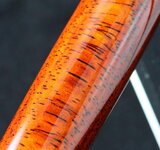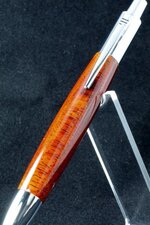yorkie
Member
My CA method
Some of this might sound goofy or silly, but I find this just works the best; for whatever reason.
I do not use bushings of any kind for my CA, just set the blank between centers and prepare to have to scrape CA off the live and dead center.
1. When you're ready to begin, wipe DNA on the blank as it's spinning on the lathe
2. Set lathe speed to around 800 rpm's (get as close to this speed as you can)
3. First coat is with thin CA and NO accelerant. I use the blue shop towels you get from auto parts stores and fold over and over lengthwise until it is about ¾ wide, about 4 foldings. I stream the thin onto the blank right to left while and follow underneath with the tip of the now folded blue shop towel. Be sure to cut it off right after and drop into water before it starts to smoke.
4. 2nd coat is thin CA with accelerant (I know some of you guys don't use accelerant at all so either way, it won't matter)
5. Buildup 7 layers of medium CA (with or without accelerant). I put a pea size drop of medium ca on the end of the folded blue shop towel and wipe this from the bottom of the blank right to left fairly swiftly. I go back and forth several times, changing the speed in which I move my finger along the blank, and removing it, but quickly putting back onto the blank once or twice-all of this action takes about 3-4 seconds. This motion is done in order to ensure the movement pattern is altered, so the CA is not allowed to form a pattern or pool on the blank. Again, right after, cut off that piece and drop it in a bucket or bowl of water before it begins to smoke.
6. Turn up lathe to around 2,000 rpm's (faster is okay but be careful of building up heat)
7. Use Abranet 600 grit and gently (heat is your enemy with CA finishes) but swiftly sand until you don't see any shine. Don't be crazy about getting it perfect, just get it really close and watch the heat build-up. This should take about 10 seconds at the most. If you start to orange peel before 7 coats, just do this step each time until you've gotten to 7 total coats.
8. Wipe off the dust with a little BLO, nothing else! Use BLO!
9. Stream two more layers of medium CA
10. Repeat step 7
11. One more layer of medium CA and then, spin your lathe at high speed for about 5 seconds and then bring it back down to 800 rpms for about 30 seconds (no accelerant at all on this final layer).
12. Remove from the lathe and let the CA cure for a day or overnight
13. Using sandpaper, or whatever method works best for you, remove the CA that has accumulated on the tips of the blank.
14. Put several drops of CA on a piece of wax paper and tap the ends (now bare wood after removing the CA that got on the tips) in the CA and kinda rub around a little, but quickly.
15. Use a cotton bud and fine paper towel (I like the Vista paper towels) to quickly wipe off the CA from inside the tube and from pooling on the ends. It will look a little messy on the ends but that will get sanded away.
16. Use wet sanding to go all the way to 12,000 grit. I sand left to right and in a circular motion, have your lathe running as fast as it will go. Keep it wet and cool.
17. Final step is to use whatever liquid you use for the final polish and apply it once or twice. Remember to not build up heat. Go light and fast.
18. Final step is to sit back and enjoy.
Some of this sounds goofy but I find it works and solves a lot of problems of blistering, cracking, splitting and that annoying bubbling you get once you've pressed the parts together.
Let me know how it turns out, guys! Good luck.
Some of this might sound goofy or silly, but I find this just works the best; for whatever reason.
I do not use bushings of any kind for my CA, just set the blank between centers and prepare to have to scrape CA off the live and dead center.
1. When you're ready to begin, wipe DNA on the blank as it's spinning on the lathe
2. Set lathe speed to around 800 rpm's (get as close to this speed as you can)
3. First coat is with thin CA and NO accelerant. I use the blue shop towels you get from auto parts stores and fold over and over lengthwise until it is about ¾ wide, about 4 foldings. I stream the thin onto the blank right to left while and follow underneath with the tip of the now folded blue shop towel. Be sure to cut it off right after and drop into water before it starts to smoke.
4. 2nd coat is thin CA with accelerant (I know some of you guys don't use accelerant at all so either way, it won't matter)
5. Buildup 7 layers of medium CA (with or without accelerant). I put a pea size drop of medium ca on the end of the folded blue shop towel and wipe this from the bottom of the blank right to left fairly swiftly. I go back and forth several times, changing the speed in which I move my finger along the blank, and removing it, but quickly putting back onto the blank once or twice-all of this action takes about 3-4 seconds. This motion is done in order to ensure the movement pattern is altered, so the CA is not allowed to form a pattern or pool on the blank. Again, right after, cut off that piece and drop it in a bucket or bowl of water before it begins to smoke.
6. Turn up lathe to around 2,000 rpm's (faster is okay but be careful of building up heat)
7. Use Abranet 600 grit and gently (heat is your enemy with CA finishes) but swiftly sand until you don't see any shine. Don't be crazy about getting it perfect, just get it really close and watch the heat build-up. This should take about 10 seconds at the most. If you start to orange peel before 7 coats, just do this step each time until you've gotten to 7 total coats.
8. Wipe off the dust with a little BLO, nothing else! Use BLO!
9. Stream two more layers of medium CA
10. Repeat step 7
11. One more layer of medium CA and then, spin your lathe at high speed for about 5 seconds and then bring it back down to 800 rpms for about 30 seconds (no accelerant at all on this final layer).
12. Remove from the lathe and let the CA cure for a day or overnight
13. Using sandpaper, or whatever method works best for you, remove the CA that has accumulated on the tips of the blank.
14. Put several drops of CA on a piece of wax paper and tap the ends (now bare wood after removing the CA that got on the tips) in the CA and kinda rub around a little, but quickly.
15. Use a cotton bud and fine paper towel (I like the Vista paper towels) to quickly wipe off the CA from inside the tube and from pooling on the ends. It will look a little messy on the ends but that will get sanded away.
16. Use wet sanding to go all the way to 12,000 grit. I sand left to right and in a circular motion, have your lathe running as fast as it will go. Keep it wet and cool.
17. Final step is to use whatever liquid you use for the final polish and apply it once or twice. Remember to not build up heat. Go light and fast.
18. Final step is to sit back and enjoy.
Some of this sounds goofy but I find it works and solves a lot of problems of blistering, cracking, splitting and that annoying bubbling you get once you've pressed the parts together.
Let me know how it turns out, guys! Good luck.


